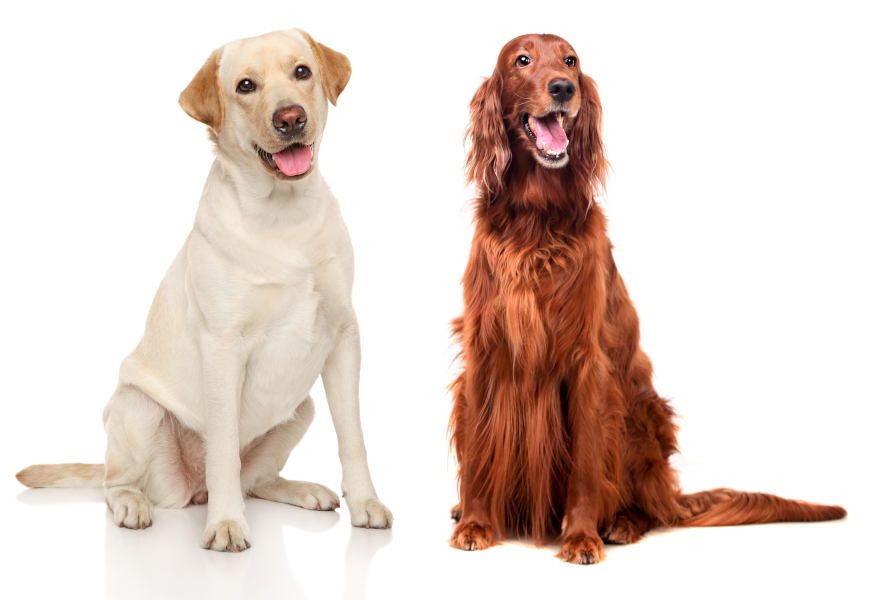Quick Summary
Click here for Price and Turnaround Time
Phenotype: See "Additional Details" section for detailed descriptions and examples of each phenotype.
Mode of Inheritance: Autosomal, allelic series with the following order of dominance Em > Eg > E > e1-3
Alleles:
Em= Melanistic mask
Eg = Grizzle
E = Black
e1 = Red/yellow
e2 = Australian Cattle Dog cream color variant (version of red/yellow)
e3 = Husky pale yellow/white variant (version of red/yellow)
Breeds appropriate for testing: Many breeds
Explanation of Results:
► Melanistic Face Mask: Dogs with Em genotype will produce melanistic face mask markings, but the visibility of the mask depends on the dog's overall coat color and whether or not expression is overridden by other genes such as white spotting. Dark-coated dogs may have a mask that is indistinguishable from body color.
- Dogs with Em/Em genotype will transmit this melanistic face mask variant to all of their offspring.
- Dogs with Em/Eg, Em/E, Em/e1, Em/e2, or Em/e3 will transmit this melanistic face mask variant to 50% of their offspring.
► Grizzle: Dogs with Eg/Eg, Eg/E, or Eg/e1 genotype will produce grizzle markings when the Dominant Black (K Locus) variant is not present (N/N) and the agouti gene is at/at. These grizzle variants are only expected among Afghan Hounds and Salukis.
- Dogs with Eg/Eg genotype will transmit this grizzle variant to all of their offspring.
- Dogs with Eg/E or Eg/e1 genotype will transmit this grizzle variant to 50% of their offspring.
► Black (E Locus): Dogs with E/E, E/e1, E/e2, or E/e3 genotype can produce black pigment in their coats, but the overall coat color exhibited by the dog is also dependent on other genes.
- Dogs with E/E genotype will transmit this black pigment variant to all of their offspring.
- Dogs with E/e1, E/e2, or E/e3 will transmit this black pigment variant to 50% of their offspring, and are carriers of red/yellow variants. Matings between two carriers of red/yellow are predicted to produce 25% of puppies with red/yellow-based coat colors.
► Red/Yellow (E Locus): Dogs with e1/e1-3, e2/e2, or e3/e3 genotype have inhibited black pigment production in their coats, leading to shades of cream, yellow, and/or red.
- Dogs with e1/e1-3 genotype are predicted to have coats in shades of cream, yellow, and/or red. They will transmit a red/yellow variant to all of their offspring.
- Dogs with e2/e2 genotype are expected only among Australian Cattle Dogs and their crossbreds and are predicted to have pale cream-colored coats. They will transmit this variant to all of their offspring.
- Dogs with e3/e3 genotype are expected only among Siberian and Alaskan Huskies and their crossbreds and are predicted to have pale yellow or white coats. They will transmit this variant to all of their offspring.
Results of this test can be submitted to the OFA (Orthopedic Foundation for Animals)
Dog Coat Color - Basic Panel (All breeds)
$100 per animal
Additional coat colors $15 per test
Dog Coat Color - French Bulldog Panel
$105 per animal
Additional coat colors $15 per test
Dog Coat Color and Type - Havanese Panel
$115 per animal
Additional coat colors $15 per test
The production of the two pigments eumelanin (black) and phaeomelanin (red/yellow) is controlled by the melanocortin 1 receptor (MC1R) gene, also known as Extension. Some dog breeds are fixed for either black or red pigment, such as the Large Munsterlander for black and Irish Setters for red. The VGL tests for six known alleles (variants) of this gene: melanistic mask (Em), grizzle (Eg), black (E), red/yellow (e1), cream (e2), and pale yellow/white (e3). The variants e1, e2, and e3 are recessive while Em and Eg are dominant. When there are multiple alleles for a given gene with some dominant and some recessive they are described as an allelic series. In dogs the MC1R allelic series has the following order of dominance Em > Eg > E > e1-3.

Melanistic face mask is found in a variety of breeds including but not limited to Afghans, Akitas, Boxers, French Bulldogs, German Shepherds, Great Danes, Greyhounds, Pug Dogs and Whippets. Dogs that are overall eumelanistic (black, blue or brown) may have the mask but it is indistinguishable from the body color. Dogs with white muzzles may have the mask gene but expression is overridden by white spotting patterns. The mask phenotype is caused by the Em variant at the MC1R gene.

Grizzle (also called domino) is a pattern of dark pigment (eumelanin) on the dorsal surface of the head, body and tops of the legs; light pigment (phaeomelanin) is present on the lower legs, undersides and up the face around the eyes. The distinctive face pattern is often referred to as a widow’s peak. This variant has only been seen in Afghan and Saluki hounds. Grizzle can only be expressed when the Dominant Black (K Locus) variant is not present (N/N) and the agouti gene is at/at.

Red/Yellow is widespread and found in the homozygous state (two copies of variant) in many dogs that are uniformly yellow, red, or cream-colored. The pale cream color produced by the e2 variant occurs in Australian Cattle Dog and appears limited to this breed and its crossbreds. The pale yellow/white color produced by the e3 variant occurs in Siberian and Alaskan Huskies and appears to be limited to these breed and their crossbreds.
This test for MC1R screens for all 6 variants to provide a complete analysis of the genotype of a dog for this gene and a better understanding of phenotype and breeding expectations.


